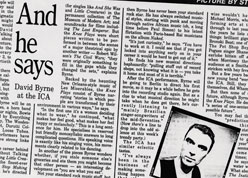ORIGINAL
PRESS CLIPPINGS

THE KNEE PLAYS: IMAGISTIC INTERLUDES FROM ROBERT WILSON
As their name implies, "The Knee Plays" were conceived as joints or interludes between the major acts of "the CIVIL warS," but they also stand on their own (like other sections of the work) as a full-fledged Wilson theater piece. They were developed in workshops at the Walker Art Center in Minneapolis, where they had their premiere in 1984.
Like most Wilson productions, ''The Knee Plays'' don't care much about storytelling. Rather, they evoke moods and impressions through a series of unpredictable images that pass across the stage in stately slow-motion. What makes ''The Knee Plays'' different from such Wilson classics as ''Einstein on the Beach'' and ''The Golden Windows'' is their extreme simplicity of means. This is signaled in the first scene, a gentle pas de deux between a sparely clad dancer and a streamlined puppet.
The rest of the evening follows the same economical pattern, no matter how bold or far-reaching the ''plot'' becomes: Objects as varied as a tree and a world-traveling boat are represented by a handful of small geometrical frames, and events are subtly suggested by sly gestures and dancelike movements. There are some stunning visual surprises, to be sure, as when ocean depths are vividly conjured up by a film projected on the backdrop. Generally, though, ''The Knee Plays'' are as lean as they are lovely, returning Wilson to the top of his form after his less-than-exhilarating ''Alcestis'' and ''Hamletmachine'' productions.
Also contributing to the evening's success is a witty music score by David Byrne, who does more with a few unamplified brass instruments (wonderfully played by Les Misérables Brass band) than I've ever heard him accomplish with his Talking Heads rock group. Byrne also wrote the show's intermittent script, a ''narration'' that has absolutely nothing to do with the visual action and is sometimes terrifically amusing, as when it serves up a string of cleverly contradictory predictions about civilization in the future. The artful choreography is by Suzushi Hanayagi; the lighting is by Heinrich Brunke. All the performers are first-rate.
The next portion of ''the CIVIL warS'' due for an American production is the so-called ''Rome Section,'' with music by Philip Glass, opening Dec. 14 at the Brooklyn Academy of Music in New York.